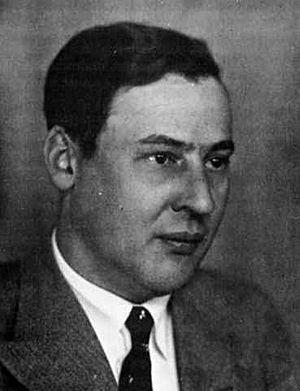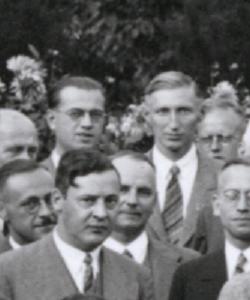Erich Hückel facts for kids
Quick facts for kids
Erich Hückel
|
|
|---|---|

Erich Hückel in 1938
|
|
| Born | August 9, 1896 |
| Died | February 16, 1980 (aged 83) |
| Known for | Debye–Hückel equation Debye–Hückel theory Hückel method Hückel rule |
Erich Armand Arthur Joseph Hückel (born August 9, 1896, in Berlin – died February 16, 1980, in Marburg) was a German physicist and physical chemist. He is known for two main contributions to science.
First, he helped create the Debye–Hückel theory. This theory explains how electrolytes (substances that conduct electricity when dissolved) behave in solutions. It looks at the forces between the charged particles in these solutions.
Second, he developed the Hückel method. This is a way to do approximate calculations for molecular orbitals. It helps scientists understand how pi electrons work in certain types of molecules.
Erich Hückel was born in the Charlottenburg area of Berlin. He studied physics and mathematics at the University of Göttingen from 1914 to 1921.
Contents
Early Career and Discoveries
After earning his doctorate degree, Hückel became an assistant at Göttingen. Soon after, he moved to Zürich to work with Peter Debye. It was there, in 1923, that Hückel and Debye developed their important theory about electrolytic solutions. This theory helped explain why strong electrolytes conduct electricity so well. It also showed how their charged particles interact with each other.
After spending time in England and Denmark in 1928 and 1929, even working briefly with the famous scientist Niels Bohr, Hückel joined the faculty at the Technische Hochschule in Stuttgart. In 1935, he moved to Phillips University in Marburg. He became a full professor there a year before he retired in 1961. He was also a member of the International Academy of Quantum Molecular Science.
Understanding Molecules: Hückel's Theories
Hückel is most famous for creating the Hückel method. This method uses a simplified quantum-mechanical approach to study flat, unsaturated organic molecules. These are molecules that contain double bonds.
How Molecules Rotate
In 1930, Hückel suggested a "sigma-pi separation" theory. This idea helped explain why alkenes (molecules with a carbon-carbon double bond) have restricted rotation. He said that only the sigma bond in ethene (a simple alkene) is symmetrical around the carbon-carbon axis. However, the pi bond is not. This difference is what stops the molecule from rotating freely.
Benzene and Aromaticity
In 1931, Hückel expanded his ideas. He described the bonding in benzene and similar molecules using both valence bond (VB) and molecular orbital (MO) theories.
Even though Hückel's ideas are now a key part of organic chemistry, they were not recognized for about 20 years. Other scientists, like Linus Pauling, found his approach "cumbersome." Pauling's own resonance theory was easier for chemists to understand. Hückel also had some trouble communicating his ideas. For example, when another chemist, Robert Robinson, asked him a question, Hückel replied that he wasn't interested in organic chemistry.
Hückel's Rule for Aromatic Compounds
The well-known Hückel 4n+2 rule helps determine if ring-shaped molecules with carbon-carbon double bonds will have special aromatic properties. This rule was first clearly explained by Doering in 1951.
Biradicals and Advanced Theories
In 1936, Hückel developed a theory for pi-conjugated biradicals. These are special molecules with two unpaired electrons. The first example of such a molecule was discovered in the same year.
In 1937, Hückel improved his molecular orbital theory for pi electrons in unsaturated organic molecules. This theory is still sometimes used today as a good approximation. Later, more precise methods like the PPP Pariser–Parr–Pople method were developed. The "Extended Hückel MO theory" (EHT) applies to both sigma and pi electrons. It started with work by William Lipscomb and Roald Hoffmann in 1962 for non-flat molecules.
Awards and Recognition
- 1965 Otto Hahn Prize for Chemistry and Physics
See also
 In Spanish: Erich Hückel para niños
In Spanish: Erich Hückel para niños


